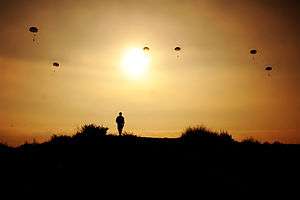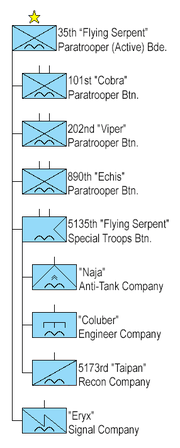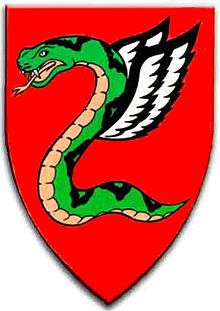Paratroopers Brigade
| Paratroopers Brigade | |
|---|---|
|
Paratroopers Brigade Insignia | |
| Active | 1955 - present |
| Country |
|
| Branch |
|
| Type | Paratrooper |
| Role |
Paratrooper Infantry Special reconnaissance |
| Size | 4 Battalions |
| Part of |
98th Paratroopers Division (Reserve), Infantry Corps |
| Motto(s) |
"Initiate, Lead, Make an Example and Win"; |
| Colors | Maroon beret, Red & White Flag |
| March | "Kol Hazman Tzanchan" (Always a paratrooper) |
| Mascot(s) | Winged Snake (Shfifon) |
| Engagements | |
| Commanders | |
| Current commander | Colonel Eliezer Toledano |
| Notable commanders | Ariel Sharon, Rafael Eitan, Moshe Ya'alon |


The Paratroopers Brigade (Hebrew: חֲטִיבַת הַצַּנְחָנִים, Hativat HaTzanhanim), also known as the 35th Brigade, is an elite unit of paratroopers within the Israel Defense Forces (IDF), and forms a major part of the Infantry Corps. It has a history of carrying out special forces-style missions dating back to the 1950s.
Paratrooper Brigade soldiers wear maroon berets with the infantry pin and reddish-brown boots. Distinct from all other soldiers of the IDF, Paratroopers wear a tunic and belt over the shirt.
The IDF has three reservist paratrooper brigades (includes the 226) at any given time, consisting of personnel who served their mandatory time in the brigade, and who are mostly relatively recently discharged, aside from officers. These are most likely the most highly trained reservist brigades in the IDF.
History
The brigade was created in the mid-1950s when the commando Unit 101 was merged with the 890th Battalion (the IDF's Airborne Commando unit) in order to form an elite infantry brigade. The new unit was equipped with the IMI Uzi submachine gun as their primary weapon as it provided light and small automatic fire, essential properties for recon units and commandos.[1]
The goals in creating the Paratroopers Brigade were:
- To have an elite leading force.
- To innovate and improve fighting skills within other units.
- To raise the next generation of military commanders and officers.
The first commander of the Paratroopers Brigade was Ariel Sharon.
The Paratroopers Brigade has had only one operational combat parachute drop, during the 1956 Sinai War. In the Six Day War (1967) the brigade took part in the capture of Jerusalem, along with the Jerusalem Brigade, Harel Brigade and armored support. The Paratroopers were the ones to capture the Western Wall and the Temple Mount, considered a historic moment and the highlight of the war by the Israeli public due to the sanctity of these places to the Jewish people.
In January 1970, during the War of Attrition, the brigade spearheaded Operation Rhodes, taking over the Egyptian island of Shadwan. Three Israeli soldiers were killed in the raid which saw the paratroopers remain on the island for 36 hours before departing with 62 Egyptian POWs and a captured Decca radar set.[2]
Over the years, the Paratroopers Brigade has been the source of several future Israeli Chiefs of Staff, including Shaul Mofaz, Moshe Ya'alon, and Benny Gantz.
Selection and training
Service in the Paratroopers is voluntary and requires passing an intense two-day selection process[3] that includes tests of physical fitness as well as emotional preparedness, leadership skills and the ability to cooperate in a group. Each year the brigade receives five times more applicants than it can accept. Paratrooper recruits go through a 7 1⁄2-month arduous training period that includes fitness training, Krav Maga training, harsh combat skills, specializing in a wide range of weapons, field craft, long marches with heavy equipment, weeks of survival training including navigation and camouflage, helicopter training, jump training, collaboration with other units, and urban warfare. More than a quarter of recruits drop out. At the end of the course, recruits must complete a "Beret March", and march 90 kilometers in full combat gear through all weather extremes, and do a round of push-ups in full combat gear near the finish line before completing the march. After they complete the march, they are officially inducted into the Paratroopers Brigade.[4]
Battles & Operations[5]
Sinai Campaign (1956)
The war began with a drop of an entire paratroop battalion over the eastern approaches to the Mitla Pass. The remaining members of the brigade force were to travel along a 300 km route (200 km deep within enemy territory) and link up with the battalion. This break-through took 28 hours, during which the column swept through the deserted Kuntilla and fought two short but fierce battles against Egyptian forces in Thamad and Nakhl. The major paratroop action during the campaign was the battle for Mitla Pass. A paratroop reconnaissance patrol entering the pass found itself trapped by an overwhelming enemy force. The Egyptians enjoyed topographical advantage, fighting from positions and niches in superior terrain. Outnumbered reinforcements who entered the fray fought desperately to rescue their comrades. After nightfall, the Egyptians were finally routed, but at the cost of 38 paratroopers dead and over 100 more wounded. Enemy losses were estimated at 260. The paratroopers jumped once again during the Sinai Campaign—at At-Tur, on the south-eastern shore of the Gulf of Suez. The rest of the brigade proceeded by land to conquer Ras Sudar and link up with their comrades at At-Tur. They then moved southeastward to Sharm-el-Sheik at the southern tip of the Sinai Peninsula—which they conquered in a classic pincers move in coordination with the 9th brigade which had been moving southwestward. After the war's end, the paratroopers concentrated on reorganization and training with emphasis on helicopter operations.
At least 49 Egyptian POWs were executed by the Paratroopers Brigade. The officer Arye Biro ordered the executions, because "We had to move on to Ras Sudar".[6]
Six Day War (1967)
During the Six Day War, the paratroopers, whose ORBAT had now increased greatly, fought on all fronts: the Sinai Peninsula, Judea, Samaria and the Golan Heights. Paratroopers and armor broke through the Rafah positions heavily defended by the Egyptian 7th Division from behind, with the unit suffering heavy losses. Many troops were further killed in action during the evacuation of the wounded. The following day, the unit entered Gaza. Paratroop forces under the command of Danny Matt, who later attained the rank of Major General, made a helicopter landing at the Um Katef artillery positions in the enemy's rear line. A battalion raced against the 7th IDF Armored Division for the honor of being the first to reach the Suez Canal. Veteran paratrooper Aharon Davidi arrived first at the banks of the Suez. During the Six Day War, paratroopers reached Sharm-el-Sheikh and likewise participated in the attack on the Golan. During the recapture of East Jerusalem from Jordanian occupation, considerable care was taken to protect and avoid damaging the holy places of the three religions. For this noble undertaking, the Paratroopers paid a heavy price in dead and wounded. After the war, paratroopers participated in pursuit and retaliation operations against Egyptian infiltrators and became embroiled in the War of Attrition on the Egyptian front. On December 23, 1969, paratroopers airlifted an entire Soviet radar station out of Egypt and transported it back to Israel.
War of Attrition (1968-73)
On March 21, 1968, paratroopers and armor raided a headquarters in Karame, Jordan, killing 250 Jordanian soldiers. On December 12, 1968, a heliborne paratroop force raided Beirut Airport and destroyed Lebanese aircraft. The raid came in response to repeated terrorist attacks against Israeli aircraft. On 12 May 1972, a hijacked Sabena airliner landed at Israel's Lod Airport (now Ben Gurion), after which paratroopers disguised as El-Al flight technicians assaulted the aircraft and rescued the passengers. On the night of April 9, 1973, during Operation Spring of Youth, a select force of paratroopers headed by Chief of Staff Lt. Gen. Amnon Lipkin-Shahak landed in different sites in and around Beirut, where according to published foreign reports, they linked up with waiting cars hired by Mossad agents. According to these sources, the soldiers drove through Beirut without arousing suspicion. They simultaneously attacked the Popular Front for the Liberation of Palestine's headquarters and the residences of three high-ranking PLO leaders responsible for the Fatah-Black September Munich massacre of Israeli athletes in 1972. Surprise was total, and despite fierce resistance in the headquarters, all teams succeeded in carrying out their missions and were extracted by Israeli Air Force helicopters. Two Israeli soldiers and dozens of PFLP fighters were killed during the fighting.
Yom Kippur War (1973)
The Yom Kippur War saw the paratroopers fighting in some of the most difficult battles of the war. In the Sinai, paratroopers assigned to armored units rescued the beleaguered 'Budapest' outpost and destroyed the Egyptian forces. Paratroopers armed with LAW missiles helped contain an Egyptian armored thrust. Paratroopers of Danny Matt's brigade crossed the canal, as the spearhead of General Sharon's divisions, and established a bridgehead. Others, attempting to break open a route for them, ran up against the massive "Chinese Farm" fortifications. For three days, paratroopers and armored corps of General Sharon's and General Adan's divisions made repeated attempts until they finally succeeded in breaking through and rescuing their comrades. During the bitter fighting, IDF soldiers ran over open ground to evacuate fallen comrades, and often fell victim to enemy fire in the process. The battles for the "Chinese Farm" prevented the Egyptians from closing in on the bridgehead and eventually succeeded in opening an access point to it. On the West Bank of the Suez Canal, paratroopers fought in the city of Suez and advanced upon the city of Ismailia. On the Syrian front, paratroopers captured the peaks of Mt. Hermon in a heliborne operation. Other troops conquered Quneitra in the Golan Heights and Tel Shams and acted as armored infantry in the thrust into Syrian territory. After the Yom Kippur War the paratroopers and other infantry units were placed under the command of a chief Paratroop and Infantry Officer.
Operation Entebbe (1976)
On the morning of July 4, 1976, a counter-terrorist hostage-rescue mission headed by Brig. Gen. Dan Shomron succeeded in rescuing 102 passengers and crew of a hijacked Air France aircraft at Entebbe, Uganda. The Paratroopers force, led by Col. Matan Vilnai, was tasked with securing the civilian airport field, clearing and securing the runways, protection and fuelling of the Israeli aircraft. The commandos, transported in four Lockheed C-130 Hercules transport planes, succeeded in landing undetected at Entebbe's airport and taking the hijackers and their Ugandan collaborators by surprise. All seven hijackers and dozens of Ugandan soldiers were killed during the mission. After the raid, the assault team returned to their aircraft and began loading the hostages where they were shot at by Ugandan soldiers. Israeli forces returned fire with their AK-47s, inflicting casualties on the Ugandans. During this brief but intense firefight, Lt. Col. Yonatan "Yoni" Netanyahu, younger brother of current Israeli Prime Minister Benjamin Netanyahu, was shot in the chest and killed during the firefight. He was the only Israeli commando killed in the operation. Three hostages were killed, one was left in Uganda, and approximately 10 were wounded. The 102 rescued hostages were flown to Israel via Nairobi, Kenya, shortly after the raid.
Operation Litani (1978)
Paratroopers participated in the 1978 invasion of Lebanon, carried out after the infamous "Coastal Road Massacre", which temporarily purged Southern Lebanon of PLO terrorists. After the IDF withdrawal and the return of sporadic attacks, the Paratroopers participated in preventive raids against bases in Lebanon, raids designed to keep the terrorists off balance and "on the run," thereby preventing them from carrying out their operations within Israel.
First Lebanon War (1982)
The paratroopers were an important component of the Lebanon War. The war in Lebanon proved the IDF's fighting ability and tested Paratroop combat doctrine, which had been revised as a result of the lessons of the Yom Kippur War, Operation Litani and other operations. Paratroopers fought in every sector of the war against Syrian troops and paratroops, both in built-up and mountainous areas. They operated efficiently and in full coordination with other corps, the Navy and the Air Force.
One of the better known operations was the amphibious landing at the mouth of the Awali river, north of Sidon, from where the paratroopers advanced to the outskirts of Beirut through the mountains. In their advance, they engaged the Syrian commando forces.[7]
Structure and Insignia
The 35th (Paratrooper) Brigade consists of three regular battalions, each bearing the name of a venomous snake. The 101st, bearing the number of disbanded Unit 101, is the Brigade's first battalion. The 202nd is the Brigade's second battalion and was numbered to keep it in line with the 101st. The 890th, although the brigade's 3rd battalion, was in fact the IDF's first paratrooper battalion. The brigade operates a special forces battalion combining the 3 special forces units of the brigade.

Soldiers of the Paratroopers Brigade are distinguished by their red beret, paratrooper wings, reddish-brown leather boots and the paratroopers tunic (Yerkit), which is slightly different in an appearance from the regular infantry outfits.
Units
(Paratrooper units are named after snakes.)
- 101st Paratrooper Battalion "Elapidae"
- 202nd Paratrooper Battalion "Viper"
- 890th Paratrooper Battalion "Echis"
- 5135th Reconnaissance Battalion "Flying Serpent"
- 5174th Anti-Tank unit "Naja"
- 5105th Engineer unit "Coluber"
- 5173rd Reconnaissance unit "Taipan"
- "Eryx" Signal Company.
See also
External links
| Wikimedia Commons has media related to Paratroopers Brigade. |
References
- ↑ Gal Perl Finkel, The combat ethos is alive and well, Israel Hayom, July 31, 2014.
- ↑ Gawrych, George Walter (2000). The albatross of decisive victory: war and policy between Egypt and Israel in the 1967 and 1973 Arab-Israeli wars. Greenwood Publishing Group. pp. 115–116. ISBN 978-0-313-31302-8.
- ↑ "Word of the Day / Gibush: Coming together like water molecules in the freezer - Word of the Day". Haaretz.com. Retrieved 2015-12-20.
- ↑ https://www.idfblog.com/blog/2012/02/21/photos-final-challenge-paratrooper-training/
- ↑ http://www.idf.il
- ↑ Fisk, Robert (2007). The great war for civilisation : the conquest of the Middle East (1. Vintage Books ed.). New York: Vintage Books. p. 916. ISBN 1400075173.
- ↑ "Paratroopers Infantry Brigade | Jewish Virtual Library". www.jewishvirtuallibrary.org. Retrieved 2015-12-20.
